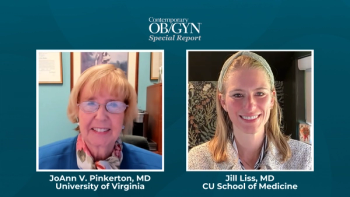
Opioid abuse and its sequelae: Treatment strategies for ob/gyns
In the second part of Dr. Lockwood's editorial on opioids, he discusses steps that ob/gyns can take to help limit opioid use disorder in our pregnant and non-pregnant patients.
Charles J Lockwood, MD, MHCMIn a previous editorial (
It is both simple logic and an established fact that reducing the quantity of opioids prescribed will reduce the occurrence of OUD, the transition to heroin, fentanyl and other illicit opioids, and overdose deaths.4 And yet, as is the case with most physicians, we ob/gyns are “systematically undertrained and under-engaged in addiction treatment efforts.”5 There are also a host of barriers to such training and engagement. For example, to prescribe buprenorphine, an opioid with lower abuse potential and an effective medication-assisted treatment (MAT) for OUD, physicians must obtain a waiver from the Drug Enforcement Administration (DEA) requiring 8 hours of training. Currently only 4% of active physicians have obtained such a waiver. Compounding the problem, insurance companies are often reluctant to cover the higher cost of buprenorphine, forcing physicians to prescribe higher-abuse-potential narcotics for patients with chronic pain.6 So what practical steps can we take to mitigate this crisis?
Strategies to prevent or reduce OUD in non-pregnant women
Prevention of OUD should be the primary focus of gynecological pain relief prescribing strategies. Acute pain associated with gyn procedures may be amenable to nerve blocks and non-opioid analgesics. When opioids are required postoperatively, provide no more than a 3-day supply of an intermediate-release agent at the lowest effective dose.7 Prescriptions for > 7 days should rarely be required.
In the setting of chronic pain (e.g., due to endometriosis), opioid prescriptions should be the last resort and administered only after a careful risk-benefit analysis. In such an evaluation, the physician should be reminded that systematic reviews have failed to demonstrate a benefit to opioid therapy in chronic pain management but do demonstrate an increased risk of OUD, overdose and other harms.8 Thus, alternative treatments such as hormonal therapy, physical therapy, exercise, alternative medicine, behavioral therapy, nonsteroidal anti-inflammatory drugs (NSAIDs) or surgery should be considered depending on the etiology. If, after exhausting all other alternatives, opioids are indicated, the following steps are recommended by the Centers for Disease Control and Prevention (CDC)7:
- Opioid therapy should be considered only if benefits, in terms of pain relief and function, outweigh risks.
- Before initiating opioid treatment, clinicians should establish treatment goals and treatment should only be continued if there is clinically meaningful improvement in pain and function that outweighs risks.
- Before initiating, and periodically while administering opioid treatment, clinicians should review risks and benefits.
- When initiating opioid therapy for chronic pain, clinicians should prescribe intermediate-release opioids and NOT extended-release (long-acting) agents which have greater risk of respiratory arrest.
- Clinicians should prescribe the lowest effective dose and carefully reassess evidence of benefit when doses ≥ 50 morphine milligram equivalents (MME)/day are required; clinicians should avoid doses ≥ 90 MME/day.
- Since long-term opioid use often begins with treatment of acute pain, adhere to the opioid prescribing recommendations made above for acute pain management (lowest dose, intermediate-release formulations, ≤ 3-day duration).
- Reassess benefits and harms within 1 to 4 weeks of starting treatment and every 3 months thereafter while treatment is continued.
- Before starting, and periodically during continuation of opioid therapy, reassess risk factors for possible harm and consider offering naloxone when factors are present that increase risk of overdose (e.g., therapy ≥ 50 MME/day or concomitant benzodiazepine therapy).
- Clinicians should review a patient’s history of controlled substance prescriptions using their state’s prescription drug monitoring program (PDMP) data (http://www.pdmpassist.org/content/state-profiles) to determine whether she is receiving opioid dosages that put her at risk for an overdose. Review PDMP data when starting opioids for chronic pain and every 3 months while on therapy.
- When prescribing opioids for chronic pain obtain urine drug testing before initiating treatment and consider annual testing to assess for prescribed medications as well as other controlled prescriptions and illicit drugs.
- Avoid prescribing concomitant benzodiazepines for patients on opioids because of their synergistic effects promoting respiratory arrest.
- Arrange for MAT with behavioral therapy for patients with OUD.
Strategies to prevent or reduce OUD in pregnant women
There are multiple risks to OUD in pregnancy. Untreated addiction to illicit opioids is associated with lack of prenatal care, risk of infectious disease, criminal activity and arrest, maternal trauma, loss of child custody, depression, under-nutrition, increased risk of fetal growth restriction, placental abruption, stillbirth and intrauterine passage of meconium.7,9 Neonatal abstinence syndrome (NAS) is a result of in utero opioid exposure, and subsequent post-delivery withdrawal is characterized by excessive crying, increased muscle tone, tremors, sweating, poor feeding, sleep disturbances and gastrointestinal dysfunction. The occurrence of NAS syndrome increased 5-fold between 2000 and 2012.7
As in the case of non-pregnant women, the best strategy to prevent occurrence of OUD in pregnant and postpartum women is to minimize or eliminate exposure to opioids in the acute pain setting. In my experience, it is rarely necessary to prescribe opioids after discharge following a vaginal delivery. If there are complications such as severe perineal trauma necessitating opioid therapy, limit duration to ≤ 3 days of a low-dose intermediate-release agent. Similarly, I rarely send patients home on opioids after an uncomplicated cesarean delivery, but again if wound complications necessitate such therapy, it should be limited to ≤ 3 days of a low-dose intermediate-release agent. As an alternative, I would prescribe NSAIDs.
For pregnant women with preexisting OUD, MAT with methadone or buprenorphine is the preferred management strategy since MAT protects the fetus from repeated withdrawal, ensures the woman stays engaged in the health care system, avoids infectious and other risks of illicit opioid use, and promotes prenatal care.7,9 Buprenorphine may be the preferred MAT agent. First, it is a partial agonist lowering abuse potential and making overdose less likely. Second, while methadone can only be dispensed by licensed opioid treatment facilities, buprenorphine can be dispensed in an office setting provided the physician has obtained a DEA waiver. Third, Buprenorphine may be more effective and also appears to induce milder NAS.7 Finally, the combination of buprenorphine and naloxone, designed to reduce the potential for intravenous abuse, appears safe to continue as MAT in pregnancy, though additional studies are needed before recommending its initiation during pregnancy.10
There is a growing consensus that MAT with either methadone or buprenorphine is preferable to medically supervised withdrawal in pregnancy because of the high relapse rates (60% to 90%) associated with withdrawal.7,9 If MAT is unavailable or if a pregnant woman insists on medically supervised withdrawal, it should occur in an inpatient setting under the care of a physician expert in this area.
Women on long-acting naltrexone therapy to maintain abstinence who conceive pose a dilemma. The impact of such therapy on the fetus and pregnancy are largely unknown, although the largest study shows no apparent risk.11 Conversely, risk of relapse after discontinuing this agent is clearly increased. Thus, a detailed discussion with the pregnant patient is needed.
A recent Committee Opinion by the American College of Obstetricians and Gynecologists (ACOG) provides the following advice9:
- Conduct early universal screening for OUD and other substance abuse, ideally at the first prenatal visit, followed by a brief intervention (e.g., short conversation, feedback and advice), and referral for MAT to improve maternal and infant outcomes (SBIR).
- Universal screening should rely on validated screening tools, such as questionnaires (e.g., 4Ps, NIDA Quick Screen, and CRAFFT for women 26 years or younger; - see Committee Opinion for descriptions of these tools [9]).
- For chronic pain, avoid or minimize use of opioids. Review alternative therapies such as nonpharmacologic approaches (e.g., exercise, physical therapy, behavioral therapy), and non-opioid pharmacologic treatments (e.g., short term acetaminophen therapy or NSAIDs < 28 weeks).
- For pregnant women with OUD, MAT is recommended over medically supervised withdrawal.
- Infants born to women who used opioids during pregnancy should be monitored by a pediatric care provider for NAS.
- Given the unique needs of pregnant women with OUD, consider modifying elements of prenatal care (e.g., expanded sexually transmitted infection testing, providing additional ultrasound examinations to rule out fetal growth restriction, and initiating consultations as needed).
- Before prescribing opioids, ensure opioids are appropriately indicated; discuss risks and benefits of use; review treatment goals; rule out history of substance use and review PDMP to determine whether patients have received prior opioid prescriptions.
- Breastfeeding should be encouraged for women on MAT, who are not using illicit drugs, and who have no other contraindications, such as HIV infection. Women should be counseled about the need to suspend breastfeeding in the event of a relapse.
- Provide postpartum psychosocial support services, including referral to treatment and relapse prevention programs.
- Contraceptive counseling and provision.
This extract was reprinted with permission from Opioid use and opioid use disorder in pregnancy. ACOG Committee Opinion No. 711. American College of Obstetricians and Gynecologists. Obstet Gynecol 2017;130:e81–94.
Take-home message
The opioid crisis has finally garnered the attention of federal and state governments, which have implemented much-needed policies such as state prescription drug monitoring programs, improved funding for treatment centers, and increased emergency access to naloxone and anti-abuse medications. However, the best strategy to end this scourge remains prevention. Because prescriptions for opioid analgesia remain the major gateway of abuse, physicians, and particularly ob/gyns must strive to avoid their use altogether for chronic pain management and minimize their use for acute pain management. When opioids are indicated for management of chronic pain in non-pregnant women, CDC guidelines should be followed. In pregnant and postpartum women, again prevention is the key with avoidance of any opioid prescription upon discharge following either vaginal or cesarean delivery. If opioids are indicated after either gynecological or obstetrical surgery, the lowest dose of an intermediate-release formulation should be given for ≤ 3 days. Finally, for pregnant women with an OUD, the optimal approach involves MAT with either methadone or buprenorphine.
REFERENCES
1. Rudd RA, Seth P, David F, Scholl L. Increases in Drug and Opioid-Involved Overdose Deaths - United States, 2010-2015. MMWR Morb Mortal Wkly Rep. 2016 Dec 30;65(5051):1445-1452.
2. Florence CS, Zhou C, Luo F, Xu L. The economic burden of prescription opioid overdose, abuse, and dependence in the United States, 2013. Med Care. 2016 Oct;54(10):901-6.
3. https://www.womenshealth.gov/files/documents/final-report-opioid-508.pdf
4. Schuchat A, Houry D, Guy GP Jr. New data on opioid use and prescribing in the United States. JAMA. 2017 Aug 1;318(5):425-426.
5. Rapoport AB, Rowley CF. Stretching the Scope - Becoming Frontline Addiction-Medicine Providers. N Engl J Med. 2017 Aug 24;377(8):705-707.
6. Thomas K, Ornstein C. Insurers putting cost over safety with painkillers. New York Times Monday September 18, 2017.
7. National Academy of Medicine, Committee on Pain Management and Regulatory Strategies to Address Prescription Opioid Abuse, Bonnie RJ, Ford MA, Phillips, Editors. Pain Management and the Opioid Epidemic. The National Academies Press. Washington, DC (prepublication copy)
8. Chou R, Turner JA, Devine EB, et al. The effectiveness and risks of long-term opioid therapy for chronic pain: a systematic review for a National Institutes of Health Pathways to Prevention Workshop. Ann Intern Med. 2015 Feb 17;162(4):276-86.
9. Committee on Obstetric Practice. Committee Opinion No. 711: Opioid Use and Opioid Use Disorder in Pregnancy. Obstet Gynecol. 2017 Aug;130(2):e81-e94.
10. Poon S, Pupco A, Koren G, Bozzo P. Safety of the newer class of opioid antagonists in pregnancy. Can Fam Physician. 2014 Jul;60(7):631-2, e348-9. English, French. PMID: 25022635
11. Kelty E, Hulse G. A retrospective cohort study of birth outcomes in neonates exposed to naltrexone in utero: A comparison with methadone-, buprenorphine- and non-opioid-exposed neonates. Drugs. 2017 Jul;77(11):1211-1219.
Newsletter
Get the latest clinical updates, case studies, and expert commentary in obstetric and gynecologic care. Sign up now to stay informed.


















